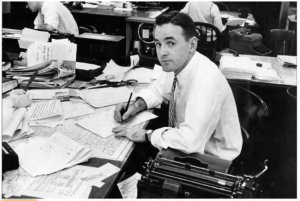
Photo info …
Credit: IndyStarView Source
(Aug. 31, 1925-Feb. 28, 2014). A lifelong Indianapolis resident, Connor graduated from Cathedral Grade School and High School and the University of Notre Dame. He grew up a mile and a half from the offices of the , where he was hired in 1949 and worked for 41 years.
Connor complemented his dedication to quality journalism with a welcoming demeanor and nimble wit. He was perpetually curious and urged the same in young reporters. The earned considerable recognition under his leadership, including both of its for investigative reporting (in 1975, as city editor, and 1991, as managing editor).
Connor’s nickname as a youth, “Bo,” stuck with him for a lifetime. Newspapering seemed his destiny: his mother, Agnes Peelle Connor, had worked for the Star and his first byline came in a weekly paper organized with other youngsters in 1937. But after serving in the Army Air Corps (1943-1946) and three years at Notre Dame “thanks to the GI Bill,” he feared newspaper life would mean meager pay. Then an uncle told him to “Do what you like…you’ll make a decent living.” He accepted the advice and joined the .
For 14 years, he advanced from police beat, to copy editor, to laying out the front page. Connor directed award-winning coverage from the scene of the fairgrounds in 1963, the year he was appointed city editor. Over the next 16 years, his staff was challenged by a massive tornado outbreak, the downtown hostage-taking by in 1977 that kept the city on edge for two-and-a-half days, and the paralyzing . As city editor, Connor also dedicated significant resources to a series unearthing police corruption, an effort awarded a Pulitzer.
Connor had a brief stint as editorial page editor before succeeding as managing editor in 1979. In that role, Connor directed the Star staff as Indianapolis’ downtown evolved from the derisively-considered “Indy-No-Place” to a bustling city center. Over the next 11 years, the city and state teemed with significant news, from to Dan Quayle’s campaign for vice president to the Indianapolis-hosted . The Star produced sizable special section coverage throughout the 23-day run of the Games.
As managing editor, Connor updated the look of the newspaper, expanded photo and design staffs, encouraged the hiring of more Blacks and women, and, in his retirement year of 1990, presided over publication of a series on medical malpractice that won a second Pulitzer.
He and his wife, Patty, raised six children. He authored two books in retirement and was inducted into the Indiana Journalism Hall of Fame in 1997.

Help improve this entry
Contribute information, offer corrections, suggest images.
You can also recommend new entries related to this topic.

